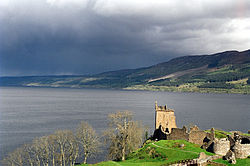Loch Ness
| Loch Ness | |
|---|---|

With Urquhart Castle in the foreground
|
|
| Location | Highland, Scotland |
| Coordinates | 57°18′N 4°27′W / 57.300°N 4.450°WCoordinates: 57°18′N 4°27′W / 57.300°N 4.450°W |
| Type | freshwater loch, oligotrophic, dimictic |
| Primary inflows | River Oich/Caledonian Canal, River Moriston, River Foyers, River Enrick, River Coiltie |
| Primary outflows | River Ness/Caledonian Canal |
| Catchment area | 1,770 km2 (685 sq mi) |
| Basin countries | Scotland |
| Max. length | 36.2 km (22.5 mi) |
| Max. width | 2.7 km (1.7 mi) |
| Surface area | 56 km2 (21.8 sq mi) |
| Average depth | 132 m (433 ft) |
| Max. depth | 226.96 m (744.6 ft) |
| Water volume | 7.5 km3 (1.8 cu mi) |
| Surface elevation | 15.8 m (52 ft) |
| Islands | 1 (Cherry Island) |
| Settlements | Fort Augustus, Invermoriston, Drumnadrochit, Abriachan, Lochend; Whitebridge, Foyers, Inverfarigaig, Dores. |
Loch Ness (/ˌlɒx ˈnɛs/; Scottish Gaelic: Loch Nis, [l̪ˠɔxˈniʃ]) is a large, deep, freshwater loch in the Scottish Highlands extending for approximately 23 miles (37 km) southwest of Inverness. Its surface is 52 ft (16 m) above sea level. Loch Ness is best known for alleged sightings of the cryptozoological Loch Ness Monster, also known affectionately as "Nessie". It is connected at the southern end by the River Oich and a section of the Caledonian Canal to Loch Oich. At the northern end there is the Bona Narrows which opens out into Loch Dochfour, which feeds the River Ness and a further section of canal to Inverness. It is one of a series of interconnected, murky bodies of water in Scotland; its water visibility is exceptionally low due to a high peat content in the surrounding soil.
Loch Ness is the second largest Scottish loch by surface area at 22 sq mi (56 km2) after Loch Lomond, but due to its great depth, it is the largest by volume in the British Isles. Its deepest point is 755 ft (230 m), making it the second deepest loch in Scotland after Loch Morar. A 2016 survey claimed to have discovered a crevice that pushed the depth to 889 ft (271 m) but further research determined it to be a sonar anomaly. It contains more fresh water than all the lakes in England and Wales combined, and is the largest body of water on the Great Glen Fault, which runs from Inverness in the north to Fort William in the south.
...
Wikipedia
